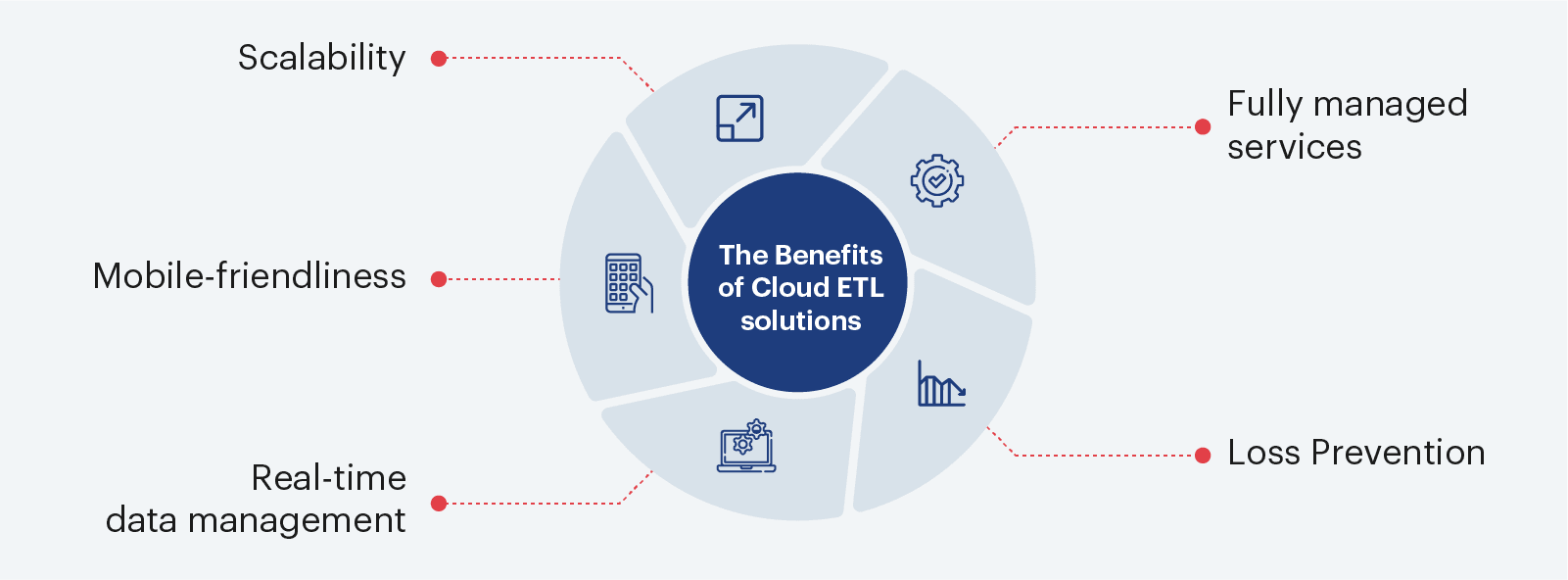ETL on Cloud: How is cloud transforming ETL for Big Data Analytics
Reading Time: 5 minutes

From streamlining the flow of information, to making business intelligence available faster at scale along with safeguarding data and lowering cost of ownership, the data warehousing process has evolved massively. Data warehouse automation now plays a critical role in that pursuit. In order to automate planning, modeling, and integrating the data lifecycle, data warehouses are now using various ETL– extract, transform, and load – solutions that run on advanced design patterns and processes.
ETL has been an essential process since the dawn of big data. Today, organizations are increasingly implementing cloud ETL tools to handle large data sets. It was common in the past for organizations to have several separate ETL resources. But, with data sets becoming larger by the day, unified ETL tools have become crucial for data integration needs of enterprises.
ETL on Cloud
New-age ETL cloud tools and systems are designed exclusively for the use of cloud computing, negating the need for on-premise infrastructures. The need to store data in cloud has increased tremendously as it promises speed, scalability and functionality. Cloud computing technology has presented companies with a new method of gathering data from multiple sources such as connected remote sensors, distributed computers, IoT, and smartphones.
Several data integration providers in the industry offer a complete range of data integration solutions tailored to satisfy consumer needs. These solutions are often customized according to the requirements of an enterprise and can incorporate data transfers across the cloud into cloud sources and on-site systems so that a business can optimize its data pool.
The Benefits of Cloud ETL solutions
Cloud ETL products have some distinct benefits for enterprises compared to on-premise data management. Here are a few:

Scalability: Cloud computing is far more scalable than on-premise data management. You can easily procure another server or buy more space if you reach the storage or processing limits of the cloud. But you would need to buy more hardware – both expensive and time-consuming – for on-premise computing.
Mobile-friendliness: Cloud platforms are now supporting devices such as smartphones, tablets, and laptops, enabling users access from anywhere. On the contrary, on-premise ETL can be reconfigured for mobile compatibility, but it usually doesn’t come with this functionality in-built.
Real-time data management: Collecting and converting data from several applications and storing it in a centralized, conveniently accessible location eliminates delays in the data stream. Additionally, ETL on cloud places the appropriate data at the user’s fingertips in microseconds.
Fully managed services: Public cloud services provide fully integrated applications for the ease of end users and also comply with service and maintenance responsibilities. Having an on-site ETL solution ensures that you will have to work with these issues yourself, which also require the employ of professional in-house tech workers.
Loss Prevention: There is a risk of losing data that is stored locally and on a handful of servers. With a cloud-based server, though, all the information that is transferred to the cloud remains secure and conveniently available from any device with an internet connection.
Factors to consider before selecting a Cloud ETL Tool

ETL is an important component of data storage and analytics, but not all ETL tools function similarly as they have different architecture and complex configurations. Choosing the appropriate ETL tool depends on the business requirement and use cases. Some considerations include:
Business Goal: When choosing an ETL cloud service, business requirements are ideally the most important consideration. In terms of speed, effectiveness, and versatility for its data integration needs, it is important to get the organization the resources it needs to perform well.
Core Features and Capabilities: The right ETL tool should cover all data sources, destinations, and transformations. Specific data quality functions, such as de-duplication and collaboration, should also be included. Good ETL tools also allow you to switch providers quickly, such as ingesting AWS and Microsoft Azure data without lengthy delays. An organization must fully understand and document the technical specifications and review them with the service provider. If all the requirements are not fulfilled, then additional internal engineering and purchase of resources have to be made, implying increased costs.
Integration: The scope and frequency of the integration efforts are important factors for determining which ETL tool works best for a business. Modern ETL approaches are required for more demanding jobs that require multiple integrations every day or those involving many decentralized sources.
Backup and Recovery: Conventional catastrophe recovery is risky and inefficient for an on-site data warehouse. In case of a crisis, businesses need “backup” storage centers ready with duplicate data. Cloud data warehouses do not need physical warehouses and keep performing periodic backups. The data is stored across nodes and is obtainable anytime without issues.
Price: The budget for a cloud ETL tool should not decrease the operating capacity or reduce the scaling goals of an organization, but should rather allow room for expansion of strategic and business value. The right technology will automate your data and free up operational hours, which can be diverted to more revenue-generating tasks. Additional maintenance and upgradation cost should also be factored in.
Security and Compliance: Does data security come with the ETL tool? Check that the architecture of the provider covers the most relevant safety and certification criteria for the industry, such as:
- GDPR compliance
- Safe Harbor
- HIPAA compliant architecture
- PCI
- SOC 2 and SOC 3
- ISO 27001 Certification
In a digitized business paradigm, ETL on cloud and utilization of cloud computing solutions are paramount to future-facing enterprises. The road ahead for data warehouse automation and seamless data management lies with cutting-edge ETL solutions and the time to adopt them is now.
About the author
Nitin is Engineering Manager at Sigmoid and has a decade of experience working with Big Data technologies. He is passionate about solving business problems across Banking, CPG, Retail, and QSR domains through his expertise in open source and cloud technologies.
Featured blogs
Subscribe to get latest insights
Talk to our experts
Get the best ROI with Sigmoid’s services in data engineering and AI
Featured blogs
Talk to our experts
Get the best ROI with Sigmoid’s services in data engineering and AI







